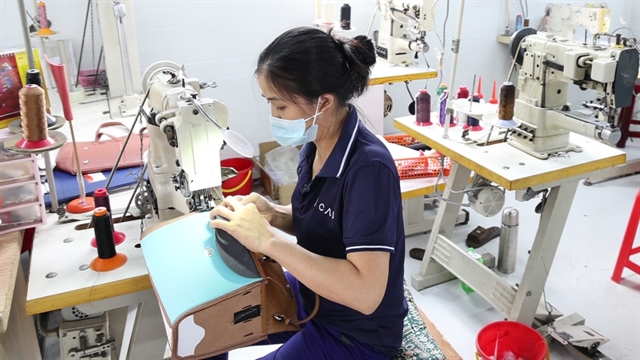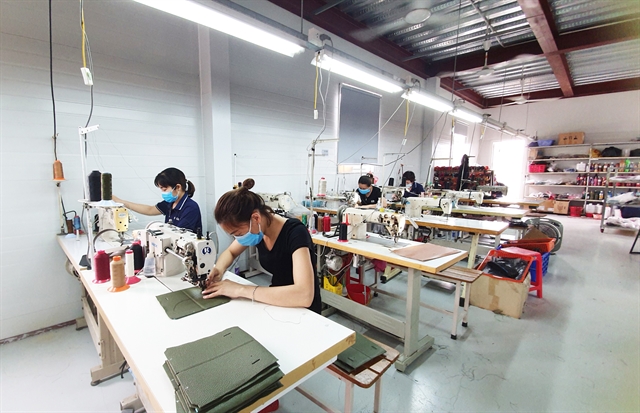 Economy
Economy

Even though efforts to contain the spread of COVID-19 have helped the country’s footwear and handbag industry attract more orders from international brands, it has still been hit hard by the pandemic in many aspects.

|
| A worker at Lecas' factory during the fourth wave of COVID-19 outbreak. VNS Photo Việt Thắng |
Ly Ly Cao & Việt Thắng
HÀ NỘI — Even though efforts to contain the spread of COVID-19 have helped the country’s footwear and handbag industry attract more orders from international brands, it has still been hit hard by the pandemic in many aspects.
The industry, which is considered to be one of the driving forces for Việt Nam economic growth, even recorded double-digit growth in footwear export turnover in the first five months of the year.
Statistics from the General Department of Việt Nam Customs showed that during this period, the country’s export turnover of footwear rose 25.4 per cent compared to the same period last year to nearly US8.4 billion, while the export turnover of handbags also grew 5.9 per cent to nearly $1.4 billion.
Footwear is one of six industries posting export turnover of more than US$5 billion in the first five months of 2021.
However, the footwear and handbag industry has been heavily affected by disruptions due to the ongoing outbreaks of COVID-19.
“We see many obstacles that enterprises, and especially footwear and handbag producers, have to face. With the most obvious challenge being weaker demand as economies worldwide suffer from the pandemic,” Phan Thị Thanh Xuân, General Secretary of Việt Nam Leather, Footwear and Handbag Association (Lefaso), told Việt Nam News.
A scarcity of containers, higher freight charges from shipping lines and shortages of cheap materials have also weighed on these companies.
“We can’t find cheap raw material sources. Therefore we have to import more expensive supplies,” Xuân added.
“Input expenses keep rising while output costs are forced down. Thus, even though we received more orders as we have controlled the pandemic well, prices are lower due to weaker buying force.”
Human resources, which has been a problem for this labour-intensive industry, is also highlighted during the tough time.
The footwear and handbag industry provides jobs for millions of workers in Việt Nam. But as there are more and more industries requiring workers, labour has been scarce.
“Because the industry needs a lot of workers, it has become a burden for companies,” Xuân said.
“Workers moved back to their hometowns when the outbreaks of COVID-19 occurred. But once the disease is contained, calling them back to factories is also a challenge.”
Lương Mai Loan, manager at a factory of Lecas, a local handbag brand, said that the pandemic has affected workers’ lives, resulting in production disruption.
“As there have been many outbreaks since the beginning of the year, schools are closed and many workers have to stay at home to take care of their children,” Loan said.

|
| Inside Lecas's factory in Hà Đông District, Hà Nội. VNS Photo Ly Ly Cao |
Overcoming tough times
Internal and external solutions have been carried out to support companies going through this difficult period. And restructuring is one of them.
“Many companies have restructured systems by applying new technology to make them more efficient and reduce the use of workers in some processes,” Xuân said.
“Or they can deploy new administration method to reduce costs.”
Phạm Thị Mai, Lecas’ owner, said that she has made big changes in the company’s human resources system, from management and workers, to business strategy.
“A year ago, we contacted some foreign companies to export our products, but the pandemic disrupted our plan, forcing us to sell solely in the domestic market,” said Mai.
“As local sales are also stagnant due to COVID-19, we changed our production by target lower income customers.”
“We are also developing online shopping channels in foreign markets, like participating in Amazon to maintain daily work-loads for workers.”
Vaccination is the best cure
As the fourth wave of the COVID-19 outbreak hit industrial areas, production activities were interrupted and vaccination is now an urgent solution.
Infection cases appeared and spread at high speed in industrial zones in Bắc Ninh, Bắc Giang and Đà Nẵng. Data compiled by the Ministry of Health showed that Bắc Giang recorded the most local cases at 5,007 as of yesterday, of which 775 cases recovered and two died.
“At the moment, customers will choose safety over other conditions to sign new contracts. Therefore our low vaccination rate is a disadvantage,” Xuân said.
“We all know this industry is labour-intensive. If we can’t secure our work force, then it will be great loss for Việt Nam and the footwear and handbag industry.”
“It will take a lot of time to recover once the chain is disrupted.”
The Government and many industry associations, including Lefaso, have held conferences to discuss the need to vaccinate workers and speed up the inoculation programme.
Việt Nam officially launched a public fund on June 5 to finance the country’s vaccine procurement. In just a week, the fund has received more than VNĐ4 trillion (US$174.4 million) and another VNĐ3.2 trillion (US$139.5 million) pledged.
As of June 16, more than 1,77 million people in Việt Nam have been injected with COVID-19 vaccines, with about 72,000 people getting the full two doses, according to the Ministry of Health. VNS

|




